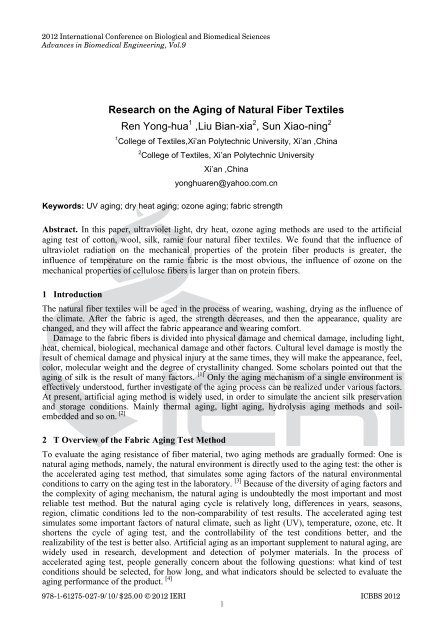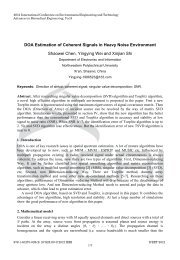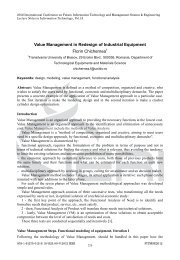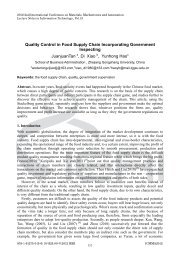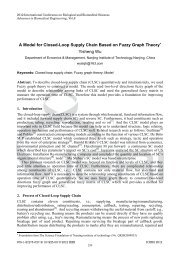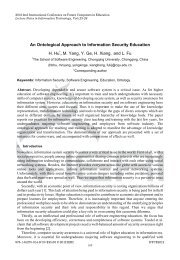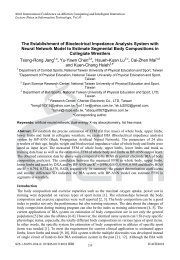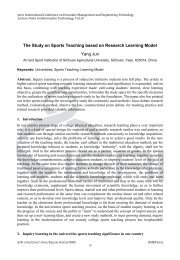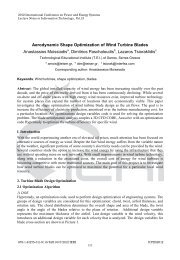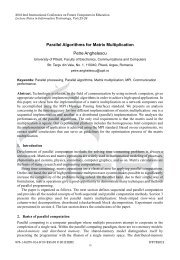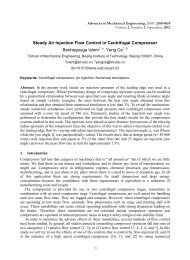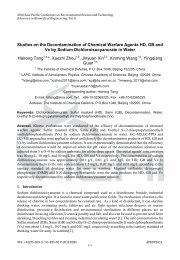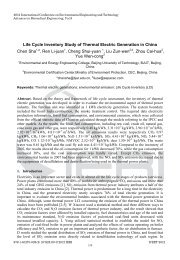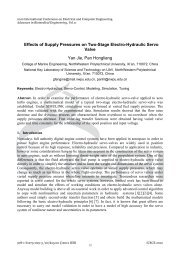Research on the Aging of Natural Fiber Textiles Ren Yong-hua1 ,Liu ...
Research on the Aging of Natural Fiber Textiles Ren Yong-hua1 ,Liu ...
Research on the Aging of Natural Fiber Textiles Ren Yong-hua1 ,Liu ...
You also want an ePaper? Increase the reach of your titles
YUMPU automatically turns print PDFs into web optimized ePapers that Google loves.
2012 Internati<strong>on</strong>al C<strong>on</strong>ference <strong>on</strong> Biological and Biomedical Sciences<br />
Advances in Biomedical Engineering, Vol.9<br />
<str<strong>on</strong>g>Research</str<strong>on</strong>g> <strong>on</strong> <strong>the</strong> <strong>Aging</strong> <strong>of</strong> <strong>Natural</strong> <strong>Fiber</strong> <strong>Textiles</strong><br />
<strong>Ren</strong> Y<strong>on</strong>g-hua 1 ,<strong>Liu</strong> Bian-xia 2 , Sun Xiao-ning 2<br />
1 College <strong>of</strong> <strong>Textiles</strong>,Xi’an Polytechnic University, Xi’an ,China<br />
2 College <strong>of</strong> <strong>Textiles</strong>, Xi’an Polytechnic University<br />
Xi’an ,China<br />
y<strong>on</strong>ghuaren@yahoo.com.cn<br />
Keywords: UV aging; dry heat aging; oz<strong>on</strong>e aging; fabric strength<br />
Abstract. In this paper, ultraviolet light, dry heat, oz<strong>on</strong>e aging methods are used to <strong>the</strong> artificial<br />
aging test <strong>of</strong> cott<strong>on</strong>, wool, silk, ramie four natural fiber textiles. We found that <strong>the</strong> influence <strong>of</strong><br />
ultraviolet radiati<strong>on</strong> <strong>on</strong> <strong>the</strong> mechanical properties <strong>of</strong> <strong>the</strong> protein fiber products is greater, <strong>the</strong><br />
influence <strong>of</strong> temperature <strong>on</strong> <strong>the</strong> ramie fabric is <strong>the</strong> most obvious, <strong>the</strong> influence <strong>of</strong> oz<strong>on</strong>e <strong>on</strong> <strong>the</strong><br />
mechanical properties <strong>of</strong> cellulose fibers is larger than <strong>on</strong> protein fibers.<br />
1 Introducti<strong>on</strong><br />
The natural fiber textiles will be aged in <strong>the</strong> process <strong>of</strong> wearing, washing, drying as <strong>the</strong> influence <strong>of</strong><br />
<strong>the</strong> climate. After <strong>the</strong> fabric is aged, <strong>the</strong> strength decreases, and <strong>the</strong>n <strong>the</strong> appearance, quality are<br />
changed, and <strong>the</strong>y will affect <strong>the</strong> fabric appearance and wearing comfort.<br />
Damage to <strong>the</strong> fabric fibers is divided into physical damage and chemical damage, including light,<br />
heat, chemical, biological, mechanical damage and o<strong>the</strong>r factors. Cultural level damage is mostly <strong>the</strong><br />
result <strong>of</strong> chemical damage and physical injury at <strong>the</strong> same times, <strong>the</strong>y will make <strong>the</strong> appearance, feel,<br />
color, molecular weight and <strong>the</strong> degree <strong>of</strong> crystallinity changed. Some scholars pointed out that <strong>the</strong><br />
aging <strong>of</strong> silk is <strong>the</strong> result <strong>of</strong> many factors. [1] Only <strong>the</strong> aging mechanism <strong>of</strong> a single envir<strong>on</strong>ment is<br />
effectively understood, fur<strong>the</strong>r investigate <strong>of</strong> <strong>the</strong> aging process can be realized under various factors.<br />
At present, artificial aging method is widely used, in order to simulate <strong>the</strong> ancient silk preservati<strong>on</strong><br />
and storage c<strong>on</strong>diti<strong>on</strong>s. Mainly <strong>the</strong>rmal aging, light aging, hydrolysis aging methods and soilembedded<br />
and so <strong>on</strong>. [2]<br />
2 T Overview <strong>of</strong> <strong>the</strong> Fabric <strong>Aging</strong> Test Method<br />
To evaluate <strong>the</strong> aging resistance <strong>of</strong> fiber material, two aging methods are gradually formed: One is<br />
natural aging methods, namely, <strong>the</strong> natural envir<strong>on</strong>ment is directly used to <strong>the</strong> aging test: <strong>the</strong> o<strong>the</strong>r is<br />
<strong>the</strong> accelerated aging test method, that simulates some aging factors <strong>of</strong> <strong>the</strong> natural envir<strong>on</strong>mental<br />
c<strong>on</strong>diti<strong>on</strong>s to carry <strong>on</strong> <strong>the</strong> aging test in <strong>the</strong> laboratory. [3] Because <strong>of</strong> <strong>the</strong> diversity <strong>of</strong> aging factors and<br />
<strong>the</strong> complexity <strong>of</strong> aging mechanism, <strong>the</strong> natural aging is undoubtedly <strong>the</strong> most important and most<br />
reliable test method. But <strong>the</strong> natural aging cycle is relatively l<strong>on</strong>g, differences in years, seas<strong>on</strong>s,<br />
regi<strong>on</strong>, climatic c<strong>on</strong>diti<strong>on</strong>s led to <strong>the</strong> n<strong>on</strong>-comparability <strong>of</strong> test results. The accelerated aging test<br />
simulates some important factors <strong>of</strong> natural climate, such as light (UV), temperature, oz<strong>on</strong>e, etc. It<br />
shortens <strong>the</strong> cycle <strong>of</strong> aging test, and <strong>the</strong> c<strong>on</strong>trollability <strong>of</strong> <strong>the</strong> test c<strong>on</strong>diti<strong>on</strong>s better, and <strong>the</strong><br />
realizability <strong>of</strong> <strong>the</strong> test is better also. Artificial aging as an important supplement to natural aging, are<br />
widely used in research, development and detecti<strong>on</strong> <strong>of</strong> polymer materials. In <strong>the</strong> process <strong>of</strong><br />
accelerated aging test, people generally c<strong>on</strong>cern about <strong>the</strong> following questi<strong>on</strong>s: what kind <strong>of</strong> test<br />
c<strong>on</strong>diti<strong>on</strong>s should be selected, for how l<strong>on</strong>g, and what indicators should be selected to evaluate <strong>the</strong><br />
aging performance <strong>of</strong> <strong>the</strong> product. [4]<br />
978-1-61275-027-9/10/$25.00 ©2012 IERI ICBBS 2012<br />
1
Currently used artificial light is trying to close to <strong>the</strong> energy distributi<strong>on</strong> curve <strong>of</strong> <strong>the</strong> solar<br />
spectrum at this wavelength range, simulati<strong>on</strong> and accelerati<strong>on</strong> rate is <strong>the</strong> main basis for selecti<strong>on</strong> <strong>of</strong><br />
artificial light. After nearly a century <strong>of</strong> development, in <strong>the</strong> laboratory <strong>the</strong>re has been enclosed<br />
carb<strong>on</strong> arc lamp light, sun-type carb<strong>on</strong> arc lamps, fluorescent UV lamps, xen<strong>on</strong> arc lamps, highpressure<br />
mercury lamp and o<strong>the</strong>r light sources to be chose. Carb<strong>on</strong> arc lamp <strong>of</strong> sunlight, fluorescent<br />
ultraviolet lamps, xen<strong>on</strong> arc lamps are recommended by <strong>the</strong> technical committees <strong>of</strong> polymer<br />
material in Internati<strong>on</strong>al Organizati<strong>on</strong> for Standardizati<strong>on</strong> (ISO). [5]<br />
In this paper, three aging methods are used to <strong>the</strong> aging research <strong>of</strong> natural fiber fabrics, namely<br />
UV aging, dry heat aging and oz<strong>on</strong>e aging. By studying <strong>the</strong> aging <strong>of</strong> <strong>the</strong> cott<strong>on</strong>, wool, silk, ramie<br />
fabric, wea<strong>the</strong>r resistance <strong>of</strong> <strong>the</strong> natural fiber textiles are fur<strong>the</strong>r learned about, it is beneficial to<br />
guide <strong>the</strong> actual producti<strong>on</strong> and <strong>the</strong> daily wear and use <strong>of</strong> textiles.<br />
3 Test<br />
3.1 Test Sample<br />
Cott<strong>on</strong>, ramie, silk, wool, each for 40 pieces, 20cm × 5cm (warp 20 pieces, weft 20 pieces)<br />
Cott<strong>on</strong> fabric: plain weave fabric<br />
Wool fabric: gabardine (yarn-dyed fabric)<br />
Silk fabric: five three flying Satin (yarn-dyed fabric)<br />
Ramie fabric: ramie grey fabric<br />
3.2 Instrument<br />
1) Oz<strong>on</strong>e aging chamber QL/J-225, produced in Wuxi City, China Test Equipment Co., Ltd.<br />
2) Dry hot aging oven LR016A, produced in Ch<strong>on</strong>gqing Yinhe Experimental Co., Ltd.<br />
3) 30W UV lamp, Shanghai Xinxin Lighting Co., Ltd.<br />
4) YG065 Fabric Strength Tester<br />
Project<br />
Cott<strong>on</strong><br />
Hair<br />
Silk<br />
Ramie<br />
TABLE I. Fabric Strength Changes After <strong>Aging</strong><br />
Normal fabric Fabric strength after aging(N)<br />
Str<strong>on</strong>g(N) UV Dry hot Oz<strong>on</strong>e<br />
warp 367 366 366 254<br />
weft 343 340 338 200<br />
warp 535 485 532 578<br />
weft 282 248 275 296<br />
warp 814 633 780 806<br />
weft 417 328 416 394<br />
warp 326 233 180 59<br />
weft 409 236 162 13<br />
3.3 Test C<strong>on</strong>diti<strong>on</strong>s<br />
1) <strong>Aging</strong> C<strong>on</strong>diti<strong>on</strong>s<br />
a) Oz<strong>on</strong>e aging<br />
Test temperature: 25℃<br />
Oz<strong>on</strong>e c<strong>on</strong>centrati<strong>on</strong>: 800pphm<br />
Air flow rate: 20nn / s<br />
Bath temperature: 40℃<br />
The samples is placed in <strong>the</strong> oz<strong>on</strong>e aging chamber, in a stable envir<strong>on</strong>ment and <strong>the</strong>n take it out<br />
after 144 hours.<br />
b) Dry hot aging<br />
2
Test parameters: c<strong>on</strong>stant temperature--105 degrees Celsius.<br />
The samples are put into <strong>the</strong> hot aging oven, and take out after 72 hours.<br />
c) Ultraviolet aging<br />
Placed 72 hours. Note: 3 days <strong>of</strong> artificial aging, <strong>the</strong> equivalent <strong>of</strong> 25 years <strong>of</strong> natural aging<br />
2) Strength test <strong>of</strong> <strong>the</strong> sample<br />
After <strong>the</strong> sample is aged, and placed it at room temperature no less than 24 h, and <strong>the</strong>n it is<br />
measured <strong>on</strong> <strong>the</strong> c<strong>on</strong>diti<strong>on</strong> <strong>of</strong> 23 ± 2 ℃.<br />
4 Test Results<br />
4.1 Horiz<strong>on</strong>tal Comparis<strong>on</strong> and Analysis <strong>of</strong> Test Results<br />
Figure 1. Strength variati<strong>on</strong> <strong>of</strong> cott<strong>on</strong> fabric<br />
Figure 2. Strength variati<strong>on</strong> <strong>of</strong> Wool fabric<br />
Figure 3. Strength variati<strong>on</strong> <strong>of</strong> silk fabric<br />
Figure 4. Strength variati<strong>on</strong> <strong>of</strong> ramie fabric<br />
Table 1 shows <strong>the</strong> strength <strong>of</strong> cott<strong>on</strong>, wool, silk, and ramie fabrics aged by different methods.<br />
Figure 1 - Figure 4 shows <strong>the</strong> data in <strong>the</strong> form <strong>of</strong> histogram representati<strong>on</strong>. The strength <strong>of</strong> cott<strong>on</strong><br />
fabric decline after oz<strong>on</strong>e aged, and <strong>the</strong> effect <strong>of</strong> ultraviolet and dry heat aging methods <strong>on</strong> <strong>the</strong> fabric<br />
strength are not obvious. Wool fabric is more sensitive to UV radiati<strong>on</strong>, and effect <strong>of</strong> temperature<br />
and oz<strong>on</strong>e is not great. The effect <strong>of</strong> UV aging methods <strong>on</strong> silk fabric is ra<strong>the</strong>r great, and dry hot and<br />
oz<strong>on</strong>e aging methods have little effect <strong>on</strong> <strong>the</strong> mechanical property <strong>of</strong> silk fabric. Three aging<br />
methods, temperature, ultraviolet and oz<strong>on</strong>e all have great influence <strong>on</strong> <strong>the</strong> ramie fabric, especially<br />
for <strong>the</strong> oz<strong>on</strong>e aging. After <strong>the</strong> ramie fabric is aged by oz<strong>on</strong>e, its strength decline is very serious. In<br />
<strong>the</strong> test process, we found that <strong>the</strong> oz<strong>on</strong>e aged ramie fabric is gently torn to pieces, and have lost<br />
value in use.<br />
3
TABLE II.<br />
Strength decline tatio <strong>of</strong> aged fabrics<br />
Project UV(%) Dry hot(%) Oz<strong>on</strong>e(%)<br />
Cott<strong>on</strong><br />
Hair<br />
Silk<br />
Ramie<br />
warp 0.27 0.27 30.79<br />
weft 0.87 1.46 41.69<br />
warp 9.35 0.56 -8.04<br />
weft 12.06 2.84 -4.96<br />
warp 22.24 4.18 0.98<br />
weft 21.34 0.24 5.52<br />
warp 28.53 44.79 81.90<br />
weft 66.75 60.39 96.82<br />
Figure 5. L<strong>on</strong>gitudinal comparis<strong>on</strong> <strong>of</strong> UV aging<br />
Figure 6. L<strong>on</strong>gitudinal comparis<strong>on</strong> <strong>of</strong> dry hot aging<br />
Figure 7. L<strong>on</strong>gitudinal comparis<strong>on</strong> <strong>of</strong> Oz<strong>on</strong>e aging<br />
4
4.2 L<strong>on</strong>gitudinal Analysis <strong>of</strong> test results<br />
The following is l<strong>on</strong>gitudinal comparative analysis <strong>of</strong> results. Table 2 and Figure 5 - Figure 7 show<br />
that strength decline ratio <strong>of</strong> <strong>the</strong> aged fabrics. It can be seen from <strong>the</strong> figure, <strong>the</strong> influence <strong>of</strong><br />
ultraviolet aging methods <strong>on</strong> wool, silk, ramie fiber textiles strength is greater, while cott<strong>on</strong> fabric is<br />
almost unaffected. Effect <strong>of</strong> dry hot aging <strong>on</strong> ramie fabric is great, its strength decreased seriously,<br />
while it has little effect <strong>on</strong> cott<strong>on</strong>, silk, wool products. The changes <strong>of</strong> strength <strong>of</strong> oz<strong>on</strong>e aged cott<strong>on</strong><br />
fabric and ramie fabrics are evident, but <strong>the</strong> effect <strong>of</strong> oz<strong>on</strong>e <strong>on</strong> wool and silk is very small. That<br />
shows <strong>the</strong> oz<strong>on</strong>e have a greater impact <strong>on</strong> <strong>the</strong> mechanical properties <strong>of</strong> cellulose fibers, but impact<br />
<strong>on</strong> protein fiber is very small.<br />
5 C<strong>on</strong>clusi<strong>on</strong><br />
1) The influence <strong>of</strong> UV <strong>on</strong> wool, silk fabric strength is larger. it indicates that protein fiber is easy<br />
to be damaged by ultraviolet radiati<strong>on</strong>, especially for silk fabric. After UV aging treatment, not <strong>on</strong>ly<br />
<strong>the</strong> strength decrease rapidly, but also a significant change in color.<br />
2) The influence <strong>of</strong> dry hot aging <strong>on</strong> cott<strong>on</strong>, wool, silk fabrics str<strong>on</strong>g <strong>of</strong> natural fiber are not very<br />
clear, <strong>the</strong> influence <strong>on</strong> strength <strong>of</strong> ramie fabric is obvious.<br />
3) The influence <strong>of</strong> oz<strong>on</strong>e <strong>on</strong> cott<strong>on</strong>, ramie fabric is str<strong>on</strong>g. That shows cellulose fibers are<br />
impatient oz<strong>on</strong>e aging. Oz<strong>on</strong>e has little effect <strong>on</strong> <strong>the</strong> mechanical properties <strong>of</strong> protein fibers.<br />
4) A ra<strong>the</strong>r obvious phenomen<strong>on</strong>, after three aging, ramie fabric strength changes are all obvious.<br />
Especially for oz<strong>on</strong>e aging, <strong>the</strong> strength decline is particularly serious, <strong>the</strong> decline value reached to<br />
96.82%. Even it caused to that <strong>the</strong> fabric strength test is difficult to realize.<br />
5) In experiment, we also found that oz<strong>on</strong>e aging not <strong>on</strong>ly has no impact <strong>on</strong> <strong>the</strong> mechanical<br />
properties <strong>of</strong> wool fiber products, instead, <strong>the</strong>re are a very small increase. To verify this phenomen<strong>on</strong>,<br />
we took three different kinds <strong>of</strong> wool fabrics to test, and are all drawn this c<strong>on</strong>clusi<strong>on</strong>.<br />
References<br />
[1] RANDALLl R B, “General effect s <strong>of</strong> aging <strong>on</strong> text ile,” J Am Inst C<strong>on</strong>serv, 1986,25( 1) pp.<br />
38- 48<br />
[2] Zhang Xuelian, “Stuby aging <strong>of</strong> <strong>the</strong> fabric by colorimetry,” Sciences <strong>of</strong> C<strong>on</strong>servati<strong>on</strong> and<br />
Archaeology,1994,6 (2) pp. 32 ~ 33<br />
[3] Wang Fangfang, Fu Jiquan, “Study <strong>on</strong> <strong>the</strong> fiber damage <strong>of</strong> artificially aged silk,” Journal <strong>of</strong><br />
Beijing Institute <strong>of</strong> Clothing Technology, Vol. 29 No. 4,Oct. 2009<br />
[4] Zhou Jingjie, Lin H<strong>on</strong>g, “Chen Yuyue etc. Study <strong>on</strong> <strong>Aging</strong> Mechanism and Protecti<strong>on</strong> <strong>of</strong><br />
Ancient Silk Textile,” Journal <strong>of</strong> Suzhou University, 2007,27 (1) pp.60 ~ 63<br />
[5] Wang Ling, “Comment <strong>on</strong> artificial accelerated ageing test,” Paint & Coatings Industry,<br />
2005,35(4)pp.1~3<br />
5


